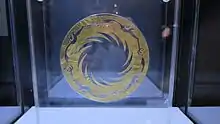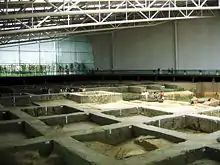Jinsha site
Jinsha (Chinese: 金沙; pinyin: Jīnshā) is an archaeological site in Chengdu, capital of China's Sichuan Province. The site is located in Qingyang District, along the Modi River (摸底河). It is named for a nearby street,[1] itself named after the Jinsha River.

The Jinsha site was accidentally discovered in February 2001 during real estate construction. Located about 50 km away from Sanxingdui, the site flourished around 1000 BC and shares similarities in burial objects with the Sanxingdui site. Ivory, jade artifacts, bronze objects, gold objects and carved stone objects were found at the site. Unlike the site at Sanxingdui, Jinsha did not have a city wall. Jinsha culture (1200–650 BC) was a final phase of Sanxingdui culture and represents a relocation of the political center in the ancient Shu Kingdom.[2] The city was built on the banks of the Modi River.
In 2013, History Channel Asia, in co-production with China International Communication Center (CICC), produced a one-hour, English-language documentary "The Lost City of Jinsha" hosted by the Chinese-American archaeologist Dr. Agnes Hsu. The film is the first episode in the documentary series Mysteries of China.[3]
Jinsha site are together with Sanxingdui and Tombs of boat-shaped coffins on Unescos list of tentative world heritage sites.[4]
Images
 Site of Jinsha, Chengdu City, Sichuan Province
Site of Jinsha, Chengdu City, Sichuan Province Golden Mask in Jinsha Site Museum
Golden Mask in Jinsha Site Museum Golden Artifacts in Jinsha Site Museum
Golden Artifacts in Jinsha Site Museum
See also
References
- Monuments of China: "Jinsha Archaeological Site". Accessed 15 August 2013.
- Yinke, Deng; Martha Avery; Yue Pan (2001). History of China. 五洲传播出版社. p. 171. ISBN 7-5085-1098-4.
- "New York Festivals - 2014 World's Best Television & Films™ Winners". www.newyorkfestivals.com.
- "Archaeological Sites of the Ancient Shu State: Site at Jinsha and Joint Tombs of Boat- shaped Coffins in Chengdu City, Sichuan Province; Site of Sanxingdui in Guanghan City, Sichuan Province 29C.BC-5C.BC". UNESCO. Retrieved 23 February 2018.
External links
| Wikimedia Commons has media related to Jinsha Site. |